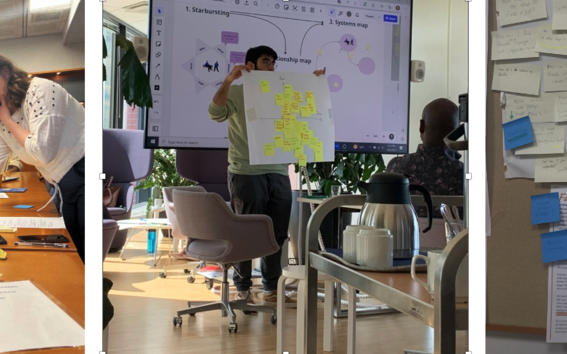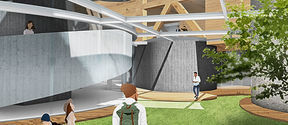Professional Cultures as an Obstacle and an Enabler for Radical Transdisciplinary Creativity
Professional cultures are largely invisible, something that we grow into. Thus, they are easily taken for granted and not really seen. On the level of everyday, they translate in profound differences in practices, attitudes, beliefs, and values, and make experts from different backgrounds to strive towards different goals. Successful transdisciplinary work requires recognizing and addressing the effect of professional cultures.

Image: Trust-M is a partnership between Aalto University, University of Helsinki, Tampere University, and City of Espoo. The project aims to create trustworthy digital public services for improved integration of migrants in Finland. In this interdisciplinary and transdisciplinary project, mutual understanding between professionals has been developed through multi-stakeholder workshops, for example.
Johanna Ylipulli, Academy of Finland Research Fellow, Department of Computer Science
Introduction
In a well-known book titled Academic tribes and territories by Tony Becher (1989) academic disciplines were argued to represent communities that could be described as ’tribes’. The author explained these ‘tribes’ were functioning on different types of ‘terrain’ that was conceptualized as consisting of different axes, namely soft and hard, pure and applied, urban and rural, and convergent and divergent. The argument was based on extensive qualitative study which indicated that behavior and values of academics are strongly conditioned by the knowledge structures of disciplines (Trowler, 2014). The original metaphor of ‘tribes’ has got an unpleasant flavor as time has passed, and it has been justly criticized due to its colonial echo. However, the basic argument of the study remains relevant: Academic disciplines differ from each other on a very profound level. Further, the profoundness of these differences applies to other professional fields as well, and more recently, researchers have approached the subject by using concepts such as professional cultures (Hall, 2005; Harris and Lyon, 2013) or knowledge communities (Paavola et al., 2004).
In some sense, the argument may seem self-evident: of course, different professionals see the surrounding world in different ways, through the lens created by their specific expertise. This is also the central reason for carrying out interdisciplinary or transdisciplinary collaboration: it intends to combine different knowledges and expert perspectives in order to create more powerful and comprehensive ways to tackle complex or ‘wicked’ problems (e.g. Bernstein, 2015). Nevertheless, the core of the issue this text wishes to address, lies in the deep and broad nature of the differences defining professional cultures – an issue that often gets ignored, especially in praxis.
It is perhaps good to note at this point that the author of this article has long experience on interdisciplinary and transdisciplinary collaboration in a very broad sense, as she has been working for 13 years at the intersection of cultural anthropology, computer science and design. These experiences have provided the motivation for this brief exploration (see e.g. Ylipulli, 2018).
Defining professional cultures
I focus here on the concept of professional culture instead of the term community, because in my view culture is more comprehensive and holds more explanatory power. According to general definition, culture can be seen as a component of society which is usually understood as the total sum of traditions, rules, symbols, and meanings that are expressed as feelings, thoughts, and behaviors of groups of people. Culture separates groups of people from each other, and it is usually passed from generation to the next one; it refers primary to learned behavior and not something that is given by nature, or biology.
In her interesting article published in 2005, Pippa Hall analyzes interprofessional teamwork within health care professionals and focuses especially on how strong professional cultures can become and obstacle for collaboration. She states, very much in line with the aforementioned general definition of culture, that “Each health care profession has a different culture, including values, beliefs, attitudes, customs and behaviours. This culture is passed on to the neophytes in the profession, but it remains obscure to other professions [Schroeder et al., 1999].” (Hall, 2005: 188.) Hall explains how different professions in the context of health care are evolved under historic forces and shaped by sociological processes; they have strived to formulate their own identity, define their values and role in patient care practice. Importantly, Hall underlines that “It is not only the educational experiences, but also the socialization process which occurs simultaneously during the training period that serves to solidify the professional’s unique world view. At the completion of their professional education, each student will have mastered not only the skills and values of his/her profession but will also be able to assume the occupational identity.” (2005: 190.) Following Petrie (1976) she further suggests that these educational and socialization processes result in ‘cognitive maps’ that are different for differing professions. These maps play an important role when we perceive professions as cultures: they are central components that lead to a situation where representatives of different professions can look at a same thing – an issue, phenomenon, or something more tangible, an artefact – and not see the same thing.
Thus, collaboration between professions requires creating opportunities in which team members could learn to understand each other’s ‘cognitive maps’. Obviously, even though Hall (2005) studies health care professionals, these arguments can easily be applied to other professions, professionals, and their collaboration as well.
To bring the discussion closer to our specific interest in this article, transdisciplinary work, we can take a look at analyses focusing especially on transdisciplinarity and professional cultures. It seems that the topic has not received any great interest from scholars but there are some significant studies on the subject. For example, Frances Harris & Fergus Lyon (2013) discuss about the professional cultures especially in the context of transdisciplinary research on sustainability. They note that each professional culture can be understood as a ‘thought collective’ having a distinct ‘style of thinking’, resembling the definition of Petrie (1976) and Hall (2005) above. They also refer to a set of more practical differences which separate professions from each other, such as “organisational forms, expectations, reward systems and organisational objectives”; these appear alongside more abstract and often implicit features such as values and social norms typical for each profession. We could also add here different communication styles, different terminology, and different intellectual and practical goals. Harris and Lyon also underline that cultural differences can exist, firstly, between academic disciplines, which echoes the classic study of Becher (1989) on ‘disciplinary tribes’; secondly, the differences are often evident also between the researcher and practitioner community.
Simon et al. (2018) point out a third level of complexity on top of the already discussed ones: transdisciplinary projects can also be transnational which means that also cultural differences between countries and regions, i.e. so-called conventional cultural differences, must be taken into account. This last group of cultural differences can affect organizational cultures on many levels. According to Simon et al. (2018: 497), these include especially 1) cultures of decision making, including “hierarchies, traditions, gender relations, levels of formal educational attainment, attitudes to age differences and the like; and 2) communication which refers to “formal and interpersonal communication, different forms of knowledge, methods of interpretation and ways of knowing, the ability and willingness to have a voice in research team discussions”. Thus, the phenomenon of professional cultures in transdisciplinary research is layered – starting with differences between academic disciplines, continuing to differences between academic and non-academic participants (or practitioners) and stretching to country-specific differences.
From obstacles of teamwork to enablers of creativity?
The deep differences between professional cultures’ worldviews, perceptions and values can cause a lot of trouble, if not addressed: they can result in misunderstandings, frustration and in the worst case, in conflicts. Overall, they can significantly diminish the quality, efficiency, and impact of transdisciplinary research. Addressing these differences with “careful and respectful exploration” is crucial – and something that cannot be emphasized too much (Simon et al 2018). Too often the differences and their profound and drastic nature are just bypassed, perhaps because having a clear motivation for research and shared goals are seen as something that automatically unites different partners of the project. However, for example Harris and Lyon (2013) argue that transdisciplinary research requires understanding the processes of research collaboration, as well as principles and practices that build trust and that go beyond having a motivation to collaborate. They highlight the meaning of transparency in building trust (Harris and Lyon, 2013). Professional cultures are largely invisible, something that we grow into; thus, they are easily taken for granted and not really seen. There is a need for practices that expose them and make them visible and understandable for everybody – as already mentioned, it is highly beneficial to learn to see the ‘cognitive map’ of one’s own and that of others (Hall, 2005). In other words, the design of these kind of projects should include phases and practices devoted to exposing, addressing, and benefitting from differences. In addition to conventional research meetings and workflow, there should be plenty of changes for knowledge sharing and mutual learning between the representatives of different professional cultures – between different disciplines but also between academic and non-academic stakeholders.
On a more concrete level, addressing these issues can begin with following good teamwork practices and research processes tailored especially to the needs of transdisciplinary projects. There exists a number of models intended to make transdisciplinary research smoother, such as transdisciplinary field guide by Utrecht University. Thus, the intention here is not to dive too deep in these guidelines.
Furthermore, Hall (2005) emphasizes specific leadership skills that are needed in managing an interprofessional team. These skills entail, first of all, an ability to recognize challenges that can rise when different professional cultures meet; secondly, they include expertise on how to bridge these differences. In addition to the skills of the leader, the composition of the whole team is highly important. This type of work requires open and flexible mindset from all; a humble attitude which enables recognizing limitations of one’s own knowledge and incomplete nature of each profession’s point of view; and willingness to negotiate between one’s own (disciplinary) goals and project’s broader, shared goals as these two do not necessarily always overlap. Building a well-functioning and effective interdisciplinary or transdisciplinary team requires extra investment, also because trust between partners develops slowly (see also Broto et al. 2009). Therefore, it would be wise to use the established relationships and established interprofessional expertise in other research projects in the future.
Overall, we can argue transdisciplinarity requires intercultural competency applied to the cultures of professions. This has several implications not only for researchers and other professionals engaged in transdisciplinary work, but also for different institutions involved in enabling and devising transdisciplinarity. These implications fall largely outside of this brief article, but a few examples may highlight these issues: To address the growing need for transdisciplinary work, educational programmes should not only take care that each student will master the skills and values of their own profession and adopts the occupational identity, but they should also provide students opportunities to get out of their professional silos and experience interdisciplinary and transdisciplinary work already during their studies, with pedagogical practices that enable the reflection of these experiences. For institutions granting funding, this means that they should not only seek novel combinations of fields but put emphasis on previous collaboration relationships and individuals’ proved capability to thrive in transdisciplinary environments.
To end with a more positive note, we can briefly ponder why, then, despite all the highlighted challenges, professional cultures can also be an enabler for transdisciplinary creativity?
Carefully and thoughtfully applied transdisciplinary research can contribute to solving ‘wicked problems’ by enabling the birth of creative friction. It can enable juxtaposing domains of though in surprising ways which echoes with the definition of metaphor coined by Lakoff & Johnson (2008); in other words, understanding a phenomenon or issue in the light of unexpected and novel framework can potentially create radically new meanings. Bridging professional cultures unlocks the power of seeing things otherwise and creates chances to expose structures that are largely taken-for-granted.
Tips how to turn different professional cultures into strength within a team/project
- Learn to recognize challenges brought by professional cultures
- Include expertise to bridge these differences
- Pay attention to the composition of the team – everybody needs an open and flexible mindset; a humble attitude and ability to recognize limitations of one’s own knowledge; and willingness to negotiate between goals
- Make extra investments to build trust
-
Embrace friction and accept plurality of worldviews.
References
Becher, T. 1989. Academic tribes and territories. Milton Keynes, SRHE and the Open University Press.
Bernstein, J.H., 2015. Transdisciplinarity: A Review of Its Origins, Development, and Current Issues. Journal of Research Practice, 11(1), pp. R1R1.
Broto, V.C., Gislason, M. and Ehlers, M.H., 2009. Practising interdisciplinarity in the interplay between disciplines: experiences of established researchers. Environmental Science & Policy, 12(7), pp.922-933.
Hall, P., 2005. Interprofessional teamwork: Professional cultures as barriers. Journal of Interprofessional care, 19(sup1), pp.188-196.
Harris, F. and Lyon, F., 2013. Transdisciplinary environmental research: Building trust across professional cultures. Environmental science & policy, 31, pp.109–119.
Lakoff, G. and Johnson, M., 2008. Metaphors we live by. University of Chicago press.
Petrie, H. G., 1976. Do you see what I see? Journal of Aesthetic Education, 10, pp. 29–43.
Simon, D., Palmer, H., Riise, J., Smit, W. and Valencia, S., 2018. The challenges of transdisciplinary knowledge production: from unilocal to comparative research. Environment and Urbanization, 30(2), pp. 481–500.
Trowler, P., 2014. Academic Tribes and Territories: the theoretical trajectory. Österreichische Zeitschrift für Geschichtswissenschaften, 25(3), pp.17–26.
Ylipulli, J., 2018. Riitasointuja vai olennaista moniäänisyyttä? Havaintoja kulttuurintutkimuksen ja tietotekniikan välimaastosta [’Conflicts or polyphony? Notes from the interdisciplinary terrain’]. In Hämeenaho Pilvi, Suopajärvi Tiina & Ylipulli Johanna (Eds.) 2018: Soveltava kulttuurintutkimus [‘Applied Studies in Culture’]. Helsinki, SKS, 225–249.
Show other posts from this blog

Fostering Border Crossing Creativity
This text highlights essential mindsets in radical creative leadership and some core concepts for fostering border crossing creativity based on discussions, workshops, and interviews organised by the Co-How team.
Recommendations Towards Critical Trans-Disciplinarity
We would like to propose the following recommendations for the basis of strategic tools and methods for radically creative trans-disciplinarity.
Consequential Pragmatism
This blog text discusses methods which combine critical thinking with practicality in architectural design process.